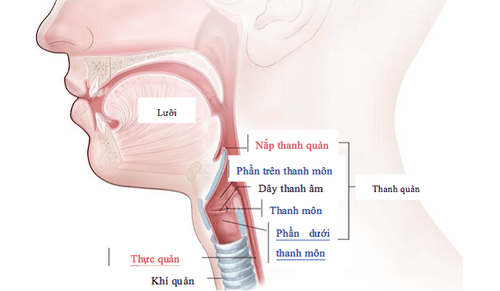This is an automatically translated article.
Laryngeal cancer is a dangerous disease with a high mortality rate if not detected and treated early. Understanding the risk factors of laryngeal cancer, accurately diagnosing the location of laryngeal cancer is a decisive requirement to improve the chances of successful treatment.1. What is laryngeal cancer?
Laryngeal cancer is a common form of ear, nose and throat cancer, accounting for about 2% of all common cancers. The disease is more common in men than women, mainly in the 50-70 year old group (72% of the total cases). Laryngeal cancer is a malignant tumor that originates from the larynx (including the lower 3 layers of the larynx, the larynx and the Morgagni larynx), the vocal cords, the subglottis or the border of the larynx. Laryngeal cancer is common in the vocal cords (accounting for 70% of cases of laryngeal cancer). Benign tumors of the larynx can also become malignant, especially laryngeal papillomas in adults.
Ung thư thanh quản là dạng ung thư tai - mũi - họng thường gặp, chiếm khoảng 2% trong tổng số các loại ung thư thường gặp
2. Risk factors for laryngeal cancer
Until now, doctors have not found the main cause of laryngeal cancer. However, they mentioned some factors that can increase the risk of disease such as:Tobacco and alcohol use: These are stimulants that contribute to the formation of laryngeal cancer and cancer. lung . People who have stopped smoking may have a reduced risk of esophageal cancer , laryngeal cancer , oral cavity cancer , pancreatic cancer and bladder cancer ; Occupational factors: Effects of occupation on workers working in chemical plants, exposed to gases or dust containing nickel, asbestos, chrome,...; There is a history of gastroesophageal reflux: When the patient finished eating, the gastric sphincter did not tighten, causing the food to be pushed back, gastric juice back up into the esophagus and larynx. Acid in gastric juice strongly affects the lining of the larynx (which does not have a structure protected from the effects of this acid) causing esophagitis, pharyngitis, laryngitis and bronchitis for a long time, easily leading to laryngitis. to laryngeal cancer; Have had radiation therapy to the front of the neck (eg, radiation therapy for thyroid cancer) or have a history of head-face-neck cancer; There are stimulating factors of the microclimate; Chronic laryngitis (premature cancer); Persistent infections of the oral cavity, ENT, ear, nose and throat, lack of vitamin A and essential nutrients; Age: The disease tends to occur in people over 55 years old; Gender: Men are four times more likely to develop laryngeal cancer than women.

Bệnh có xu hướng gặp ở người trên 55 tuổi
3. Location of laryngeal cancer
Laryngeal malignancies are common in the following locations:3.1 Epiglottitis (laryngeal vestibule) Malignant tumors often arise at the same time on both the underside of the larynx and the larynx. The tumor spread rapidly to the opposite side. Radiator splints and the funnel cartilage area on the side of the tumor are often enlarged due to tumor infiltrates or edema. In the early stages, the diagnosis must use CT scan to assess the temperature in advance.
Malignant tumors arising from the ventricles of Morgagni are usually proliferative or ulcerative. Ulcers will spread very quickly to nearby areas.
Epiglottitis usually accounts for about 8-10 of all laryngeal cancers. Symptoms of the disease often appear late with manifestations such as hoarseness (when the tumor spreads into the vocal cord mucosa and funnel cartilage), painful swallowing (when the tumor spreads into the pharynx, larynx).
3.2 Cancer of the glottis (vocal cord) This is the most common form of laryngeal cancer, if detected early, the tumor will be limited to the upper surface or free margin of the vocal cords. This form of cancer is often proliferative, rarely infiltrative or ulcerative. Cancer of the vocal cords progresses quite slowly, staying on one side for a long time before spreading to the opposite side.
Patients with laryngeal cancer are often detected early because of the early onset of difficult-to-pronounce symptoms. Patients present with voice disturbances, prolonged hoarseness, increasing levels. Later, speaking very hoarse, tired, accompanied by an irritated cough, coughing up foul-smelling sputum, ... Late signs include coughing up mucus and blood, pain in the anterior larynx, pain may spread to the larynx. Ear, discomfort, foreign body in throat, difficulty breathing, swallowing disorder, difficulty swallowing, choking, pain,...
3.3 Subglottic cancer This is a less common form of laryngeal cancer than the other 2 types. and more difficult to detect. To accurately identify subglottic cancer, it is necessary to direct laryngoscopy and computed tomography.
Common subglottic cancer is infiltrative form, usually below the vocal cords, is blocked by the thyroid cartilage, so it is difficult for the tumor to spread out. Malignant tumors often grow rapidly to the contralateral side, cross the anterior margin of the larynx, and then extend below the cricoid cartilage.

Nếu không được điều trị sớm, bệnh nhân ung thư thanh quản thường có thời gian sống ngắn
Currently Vinmec International General Hospital is implementing a package of screening and early detection of oropharyngeal, hypopharyngeal and laryngeal cancers including:
Full range of necessary services for early detection of oropharyngeal cancer showing other abnormalities in the arch - hypopharynx - larynx area When registering for the screening package, and early detection of nasopharyngeal, hypopharyngeal, laryngeal cancer, customers will be screened for nasopharyngeal - hypopharyngeal cancer - larynx through general otolaryngology examination with hard or soft endoscope; Software ultrasound, thereby detecting the disease early, improving the effectiveness of treatment, increasing the survival rate for patients.
To register for examination and treatment at Vinmec International General Hospital, you can contact Vinmec Health System nationwide, or register online HERE.
Recommended video:
What parts does the upper respiratory tract consist of? Common diseases of the upper respiratory tract
SEE MORE
Losing voice what to do? Causes of oropharyngeal cancer Causes and treatment of chronic laryngitis













